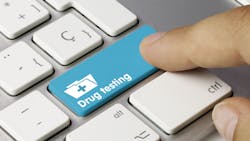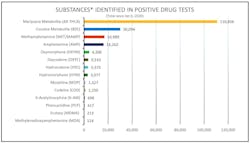June 1 was supposed to be the red-letter day for oral-fluid testing for drug use among transportation employees and truck drivers—except it wasn't.
A year after proposed rulemaking, a May 2 decision from the U.S. Department of Transportation officially sanctioned saliva screenings as a second method acceptable for the Drug & Alcohol Clearinghouse. Thursday was supposed to be the phase-in day for the program. There's a significant snag, however, one that was foreseen by industry stakeholders when the decision was announced early last month.
The testing method—which joins urinalysis—for all transportation workers now must wait on a separate federal agency, the U.S. Department of Health and Human Services, to approve at least one primary test-processing laboratory and one secondary lab to implement saliva screening as an alternative to urinalysis as a screening method for banned substances.
See also: DOT finalizes oral fluid drug-testing rule
HHS officials have not released advice on when the laboratories will gain approval, and three FleetOwner requests to the federal government agency for information went unanswered this week. An HHS post on the Federal Register simply says: "At this time, there are no laboratories certified to conduct drug and specimen validity tests on oral fluid specimens."
This leaves trucking industry stakeholders questioning when they can conduct oral-fluid testing and have those results accepted by the clearinghouse. Any fleet can screen in most ways it wishes—including through hair-follicle testing, which still isn't sanctioned for the clearinghouse—for internal pre-employment and random testing purposes. But only urine and oral fluid, pending the lab approvals, will be accepted by the clearinghouse, according to DOT.
One stakeholder, Shawn O'Neil, who is compliance and privacy officer for Vault Workforce Screening, a third-party drug-testing administrator with trucking industry clients, told FleetOwner that the delay for HHS lab certification could last perhaps two months or more—mostly because reagent chemicals used in the testing devices must be validated. Then HHS must certify at least two national labs because samples are split in two so that if one returns a positive, the result can be independently validated by a second lab, O'Neil explained in a June 1 interview.
"Get ahead of it. They can educate their employees. They can do some homework right now," he added.
See also: Post-accident positive marijuana results reach 25-year high in U.S. workforce
What else does saliva testing do for a trucking company? "It gives them flexibility," O'Neil noted, giving them a second kind of specimen to screen, ensuring the accuracy of results. Among other services, Vault provides commercial fleets access to nationally certified medical review officers, who can validate and counsel those employees who have popped positive test results.
How saliva testing can fit into a fleet's protocols
According to the final Department of Transportation rulemaking, transportation employees (including commercial truck drivers) could be subject to either an oral-fluid sampling or a urine collection for any DOT-regulated test in pre-employment, randomly, under reasonable suspicion of drug use and for cause, after an accident, or for return-to-duty (RTD) and follow-up screening as part of the clearinghouse RTD process.
If there is a reason a second collection is needed during the testing event (for example, the initial temperature is out-of-range for a urine specimen or an insufficient quantity for either oral fluid or a urine specimen), the employer may choose to change to the other type of collection to finish the testing event, according to DOT. The choice of whether to conduct an oral fluid or a urine test is entirely up to the employer, according to the new DOT rules. DOT also has said that oral-fluid testing is generally less expensive for fleet operators or owner-operators (by $10 to $20) than urine testing.
On June 1, DOT also issued updated guidance for Substance Abuse Professionals (SAPs), who evaluate transportation employees when they have a positive drug test and are found to be violating DOT's drug-and-alcohol regulation program.
Once a transportation employee enters the return-to-duty process, it's SAPs who supervise the education, testing, and treatment program required of the employee as part of RTD, which can take months or even years. Since 2020, 97,833 CDL holders haven't started the process after a positive test result, meaning they've given up driving or are doing so illegally.
About the Author
Scott Achelpohl
Managing Editor
Scott Achelpohl is a former FleetOwner managing editor who wrote for the publication from 2021 to 2023. Since 2023, he has served as managing editor of Endeavor Business Media's Smart Industry, a FleetOwner affiliate.


